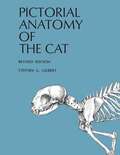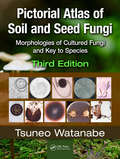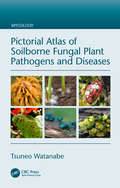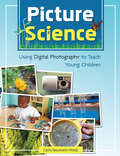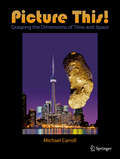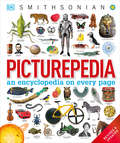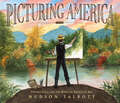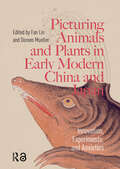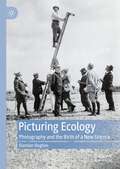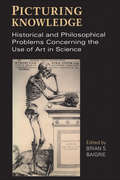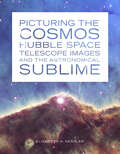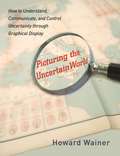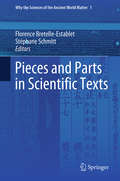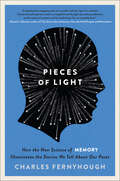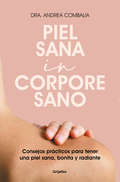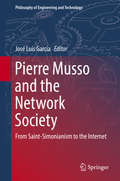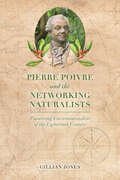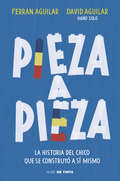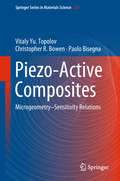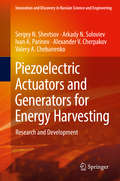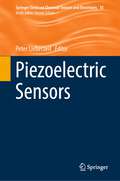- Table View
- List View
Pictorial Anatomy Of The Cat
by Stephen G. GilbertThis book is designed for use as a dissection guide in comparative vertebrate anatomy or in mammalian anatomy. The material covered and the time allotted to such courses varies considerably, and the illustrations are therefore designed to enable the instructor to point out the important features of areas which cannot be dissected in detail by every student.
Pictorial Atlas of Soil and Seed Fungi: Morphologies of Cultured Fungi and Key to Species,Third Edition (Mycology)
by Tsuneo WatanabeThis third edition describes and illustrates more than 515 fungal species, including 49 oomycetous, 35 zygomycetous, 49 ascomycetous, 38 basidiomycetous, and 344 anamorphic species. All fungi are described alphabetically in order of Oomycota, Zygomycota, Ascomycota, Basidiomycota, and Anamorphic (Deuteromycetous) fungi. For each genus, the atlas includes type species, references, morphology, and materials. The book illustrates all fungi alongside morphologies and colonies of their fresh agar cultures or dried specimens, providing ready access to morphologically similar fungi for quick comparison. This edition also contains a bonus CD-ROM, which includes color versions of all images from the book.
Pictorial Atlas of Soilborne Fungal Plant Pathogens and Diseases (Mycology #34)
by Tsuneo WatanabeThe Pictorial Atlas of Soilborne Fungal Plant Pathogens and Diseases describes the soilborne fungal diseases caused by Oomycetes, Zygomycetes, Ascomycetes, Basidiomycetes, and Deuteromycetous (Anamorphic) fungi. Soilborne fungal diseases are significant as both environmental and agricultural problems, yet it is difficult to understand the ecology of pathogenic fungi and its effective control. This book provides very detailed information on many of the commonly and not so commonly encountered groups of soilborne fungi diseases. It will be a useful reference for those teaching and conducting research in mycology, plant pathology, soilborne plant diseases, and the ecology of fungal communities.
Picture Science
by Carla Neumann-HindsMake digital photography an important part of your early childhood program!Young children love to investigate the natural world, and they love to take photographs.Picture Science will help you go beyond just documenting class projects. It will show you how to use digital photography to make each step in the scientific process-from posing a question, to gathering data, to showing your findings-concrete and fun for children.Keyed throughout to early learning standards, Picture Science provides inspiring examples that will stimulate you to design your own lesson plans. Technical advice and tips for buying a camera for your center or family child care business are included as well.Picture Science won the prestigious 2007 Directors' Choice Award and Judges' Selection Award from Early Childhood News
Picture This!
by Michael CarrollAstronomical concepts can be truly hard to comprehend, especially those of planetary sizes and distances from Earth and from each other. These concepts are made more comprehensible by the group of illustrations in this book, which put scale extraterrestrial objects side by side with objects on Earth we can more easily relate to. For example, study the pictures of Earth floating above Jupiter's Great Red Spot and the asteroid Itokawa resting beside Toronto's CN Tower. These mind-bending images bring things better into perspective and will help you understand the size and scale of our Solar System. In later chapters, you will be told how close the visionaries of the past came to guessing what today's explorers would find. Astronomer/painter Lucien Rudaux's masterpieces of Mars dust storms anticipated Viking and Mars rover images by nearly a century. Space artist Ludek Pesek envisioned astronauts setting up camp on the lunar surface in scenes hauntingly similar to photos taken by Apollo astronauts decades later. But the real benefit of this work is in better grasping the nature of our universe -- how big it is, now large it is, and how we fit into it.
Picturepedia: An Encyclopedia on Every Page
by DKDiscover everything you could ever know about science and technology, nature, geography, culture, sports and hobbies, and history in this vibrant visual encyclopedia for children! Did you know that more than half of the human body&’s weight is water, and that a koi carp can live for more than 200 years? Or how about there being more than 20,000 islands in the Pacific Ocean, or that Turkey eats the most bread, with each person getting through 104.6 kg of it every year? You can learn all these things and more with Picturepedia, and become an expert in everything from incredible insects and musical instruments, to space-craft, prehistoric life and everything in between, with this engaging encyclopedia for children aged 9-12.Celebrate your child's curiosity as they explore:- Each topic is covered on one double-page spread- Comprehensive coverage of over 150 popular topics.- Each topic is illustrated with up to 100 photos, graphics, and illustrations.- Fun, visual approach combines unprecedented density of detail with crystal-clear structure.- Includes timelines, top ten lists, step by steps, fun facts, and more.First published in 2015, Picturepedia has been revamped into a more thrilling edition that will take you on a visual odyssey. This captivating kid&’s encyclopedia is jam-packed with stunning photographs, gripping information, and explanatory diagrams that allow for fascinating discoveries. Newly updated with thousands of pictures and fascinating facts about science, nature, culture, sports, and history, Picturepedia is the ultimate visual encyclopedia for kids. With 5 core chapters split into the topics of Science and Technology, Nature, Geography, Culture, Sports and Hobbies, there truly is something for every avid young reader to explore and learn, making this an excellent reference book for curriculum-based homework help. The striking graphics and illustrations featured throughout provide an optimum visual learning experience for children ages 9-12 years, that adults can also enjoy. With over 10,000 images in total, more so than any other encyclopedia on the market, this enthralling children&’s encyclopedia can make a beautiful and educational gift that can be passed down generations.
Picturing America: Thomas Cole and the Birth of American Art
by Hudson TalbottThis fascinating look at artist Thomas Cole's life takes readers from his humble beginnings to his development of a new painting style that became America's first formal art movement: the Hudson River school of painting.Thomas Cole was always looking for something new to draw. Born in England during the Industrial Revolution, he was fascinated by tales of the American countryside, and was ecstatic to move there in 1818. The life of an artist was difficult at first, however Thomas kept his dream alive by drawing constantly and seeking out other artists. But everything changed for him when he was given a ticket for a boat trip up the Hudson River to see the wilderness of the Catskill Mountains. The haunting beauty of the landscape sparked his imagination and would inspire him for the rest of his life. The majestic paintings that followed struck a chord with the public and drew other artists to follow in his footsteps, in the first art movement born in America. His landscape paintings also started a conversation on how to protect the country's wild beauty. Hudson Talbott takes readers on a unique journey as he depicts the immigrant artist falling in love with--and fighting to preserve--his new country.
Picturing Animals and Plants in Early Modern China and Japan: Innovation, Experiments, and Anxieties
by Fan Lin Doreen MuellerThe seven articles in this edited volume address the complex meanings that visual representations of plants and animals gained in early modern China and Japan. They aim to understand animals and plants in the new contexts of empirical and epistemological concerns, political and social agendas, and cultural interests. In particular, they examine the ways in which scholars, professional painters, and publishers engendered the sociohistorical meanings of the images.
Picturing Ecology: Photography and the birth of a new science
by Damian HughesThis book examines the role of photography and visual culture in the emergence of ecological science between 1895 and 1939.
Picturing Knowledge: Historical and Philosophical Problems Concerning the Use of Art in Science
by Brian BaigrieThe traditional concept of scientific knowledge places a premium on thinking, not visualizing. Scientific illustrations are still generally regarded as devices that serve as heuristic aids when reasoning breaks down. When scientific illustration is not used in this disparaging sense as a linguistic aid, it is most often employed as a metaphor with no special visual content. What distinguishes pictorial devices as resources for doing science, and the special problems that are raised by the mere presence of visual elements in scientific treatises, tends to be overlooked.The contributors to this volume examine the historical and philosophical issues concerning the role that scientific illustration plays in the creation of scientific knowledge. They regard both text and picture as resources that scientists employ in their practical activities, their value as scientific resources deriving from their ability to convey information.
Picturing the Cosmos: Hubble Space Telescope Images and the Astronomical Sublime
by Elizabeth A. KesslerThe vivid, dramatic images of distant stars and galaxies taken by the Hubble Space Telescope have come to define how we visualize the cosmos. In their immediacy and vibrancy, photographs from the Hubble show what future generations of space travelers might see should they venture beyond our solar system. But their brilliant hues and precise details are not simply products of the telescope&’s unprecedented orbital location and technologically advanced optical system. Rather, they result from a series of deliberate decisions made by the astronomers who convert raw data from the Hubble into spectacular pictures by assigning colors, adjusting contrast, and actively composing the images, balancing the desire for an aesthetically pleasing representation with the need for a scientifically valid one.In Picturing the Cosmos, Elizabeth A. Kessler examines the Hubble&’s deep space images, highlighting the remarkable resemblance they bear to nineteenth-century paintings and photographs of the American West and their invocation of the visual language of the sublime. Drawing on art history and the history of science, as well as interviews with astronomers who work on the Hubble Heritage Project, Kessler traces the ways that the sublime, with its inherent tension between reason and imagination, not only forms the appearance of the images, but also operates on other levels. The sublime informs the dual expression—numeric and pictorial—of digital data and underpins the relevance of the frontier for a new era of exploration performed by our instruments rather than our bodies. Through their engagement with the sublime the Hubble images are a complex act of translation that encourages an experience of the universe as simultaneously beyond humanity&’s grasp and within the reach of our knowledge.Strikingly illustrated with full-color images, this book reveals the scientific, aesthetic, and cultural significance of the Hubble pictures, offering a nuanced understanding of how they shape our ideas—and dreams—about the cosmos and our places within it.
Picturing the Uncertain World: How to Understand, Communicate, and Control Uncertainty through Graphical Display
by Howard WainerIn his entertaining and informative book Graphic Discovery, Howard Wainer unlocked the power of graphical display to make complex problems clear. Now he's back with Picturing the Uncertain World, a book that explores how graphs can serve as maps to guide us when the information we have is ambiguous or incomplete. Using a visually diverse sampling of graphical display, from heartrending autobiographical displays of genocide in the Kovno ghetto to the "Pie Chart of Mystery" in a New Yorker cartoon, Wainer illustrates the many ways graphs can be used--and misused--as we try to make sense of an uncertain world.Picturing the Uncertain World takes readers on an extraordinary graphical adventure, revealing how the visual communication of data offers answers to vexing questions yet also highlights the measure of uncertainty in almost everything we do. Are cancer rates higher or lower in rural communities? How can you know how much money to sock away for retirement when you don't know when you'll die? And where exactly did nineteenth-century novelists get their ideas? These are some of the fascinating questions Wainer invites readers to consider. Along the way he traces the origins and development of graphical display, from William Playfair, who pioneered the use of graphs in the eighteenth century, to instances today where the public has been misled through poorly designed graphs. We live in a world full of uncertainty, yet it is within our grasp to take its measure. Read Picturing the Uncertain World and learn how.
Pieces and Parts in Scientific Texts (Why the Sciences of the Ancient World Matter #1)
by Florence Bretelle-Establet Stéphane SchmittThis book starts from a first general observation: there are very diverse ways to frame and convey scientific knowledge in texts. It then analyzes texts on mathematics, astronomy, medicine and life sciences, produced in various parts of the globe and in different time periods, and examines the reasons behind the segmentation of texts and the consequences of such textual divisions. How can historians and philosophers of science approach this diversity, and what is at stake in dealing with it? The book addresses these questions, adopting a specific approach to do so. In order to shed light on the diversity of organizational patterns and rhetorical strategies in scientific texts, and to question the rationale behind the choices made to present such texts in one particular way, it focuses on the issue of text segmentation, offering answers to questions such as: What was the meaning of segmenting texts into paragraphs, chapters, sections and clusters? Was segmentation used to delimit self-contained units, or to mark breaks in the physical appearance of a text in order to aid reading and memorizing, or to cope with the constraints of the material supports? How, in these different settings and in different texts, were pieces and parts made visible?
Pieces of Light: How the New Science of Memory Illuminates the Stories We Tell About Our Pasts
by Charles FernyhoughIn a blend of memoir and science, a psychologist presents a “thoughtful exploration” of autobiographical memory (Booklist).A new consensus is emerging among cognitive scientists: rather than possessing fixed, unchanging memories, we create new recollections each time we are called upon to remember. As psychologist Charles Fernyhough explains, remembering is an act of narrative imagination as much as it is the product of a neurological process. In Pieces of Light, he illuminates this compelling scientific breakthrough in a series of personal stories, each illustrating memory’s complex synergy of cognitive and neurological functions.Combining science and literature, the ordinary and the extraordinary, this fascinating tour through the new science of autobiographical memory helps us better understand the ways we remember—and the ways we forget. Book of the Year: Sunday Times, Sunday Express, and New Scientist
Piel sana in corpore sano: Consejos prácticos para tener una piel sana, bonita y radiante
by Dra. Andrea CombaliaUna invitación a un estilo de vida saludable, a la prevención de ciertas enfermedades y al cuidado y belleza del único órgano visible para todos: la piel. La Dra. Andrea Combalia, médico dermatóloga, con más de 50.000 seguidores en su revista digital Piel sana in corpore sano, nos resuelve las dudas y nos lanza prácticos consejos para que la salud y la belleza de la piel estén al alcance de todos. ¿Cómo influye el estrés sobre nuestra piel? ¿Cómo podemos saber si un lunar es maligno? ¿Cada cuando debemos lavarnos el pelo? Desde su belleza hasta sus arrugas e imperfecciones, la piel es un órgano de nuestro cuerpo que nos seduce a la vez que nos obsesiona. La piel nos envuelve y nos protege, la podemos ver, tocar y sentir, y experimenta cambios a lo largo de la vida. Además, la piel nos comunica y nos transmite el estado de nuestro cuerpo y nuestra mente, de modo que no solo es importante cuidarla por cuestiones estéticas, sino que su bienestar es esencial.
Pierre Musso and the Network Society
by José Luís GarciaThis book is devoted to discussion of the views of Pierre Musso and starts with a central chapter written by Musso, entitled Network Ideology: from Saint-Simonianism to the Internet . Pierre Musso is a French philosopher and is one of the most original thinkers in the history of the network society. His thought develops a critique of information and communication technologies through their imaginary and social representations and of the information society, based on the network metaphor.The main question on which Musso has focused his attention is how the network metaphor is one of the most powerful ways of understanding the complex societies in which we live. Showing characteristic attention to detail, and drawing on the history of ideas, political philosophy and sociology, Musso traces the genealogy of the network imaginary, and points out that it did not emerge with the Internet. He shows how its modern roots can be found in Henri de Saint-Simon and his disciples, engineers and entrepreneurs such as Michel de Chevalier, and Barthélemy Prosper Enfantin, who developed channel networks, railroads, and the telegraphic network in France in the nineteenth century. In addition to the central piece written by Musso, the book includes a general introduction and six commentaries from experts on information technologies and networks. It displays a wide range of perspectives from a diverse set of authors in terms of nationalities and universities, as well as disciplinary backgrounds.
Pierre Poivre and the Networking Naturalists: Pioneering Environmentalists of the Eighteenth Century
by Gillian JonesAlthough climate change is seen as a very 21st-century concern, back in the eighteenth and early nineteenth century naturalists around the world in places as far apart as Mauritius in the Indian ocean and St Vincent in the Caribbean were becoming aware of what they referred to as desiccation, the drying of the land and absence of rainfall due to the cutting down of large swathes of forest trees. This book traces the connections between those naturalists, scientists and men of letters to reveal the surprising truths that they discovered and which must inspire us to follow the trail they blazed.
Pierre-Daniel Huet (International Archives of the History of Ideas Archives internationales d'histoire des idées #238)
by José R. Maia NetoThis book offers a detailed and scholarly historical and philosophical examination of French scepticism from Descartes to the beginning of the Enlightenment by examining the views of Pierre-Daniel Huet (1630–1721). It shows the crucial role played by Huet in the modification of the early modern sceptical tradition: from a practical perspective closer to ancient scepticism, mostly presented by Montaigne and Charron, to an epistemological and metaphysical perspective strongly influenced by Descartes’s doubt. The book examines and gives original interpretations of the various sceptical (and semi-sceptical) views held in the period and their connections to Huet’s own scepticism. Besides known philosophers such as Descartes, Gassendi, Pascal and Bayle, the book also accesses sceptical views held by secondary figures such as La Mothe Le Vayer and Simon Foucher and others who have not thus far been connected to the sceptical tradition such as Jean-Baptiste du Hamel and Madeleine de Scudéry. The book is useful for scholars in the field of early modern ideas: philosophical, religious and scientific.
Pietro Blaserna and the Birth of the Institute of Physics in Rome: A Gentleman Scientist at Via Panisperna (Springer Biographies)
by Miriam FocacciaThis book draws upon a wealth of archival material to present the life and achievements of Pietro Blaserna, a “gentleman scientist” whose greatest legacy is considered to be the Institute of Physics on the Via Panisperna in Rome, of which he was the creator and first director. Both in this role and as President of the Accademia dei Lincei, Blaserna contributed enormously in establishing a sound institutional base for the further development of physics in Italy. Starting from an accurate historical reconstruction of the scientific, social, and political context, the author presents the different phases of Pietro Blaserna’s life and career. As a multifaceted intellectual and a scientist holding several institutional positions, Blaserna worked ceaselessly to promote an effective policy in science and technology, which was critically important in stimulating the development of Italy as a modern nation. Blaserna may not have left scientific works that made history, but what he created in Rome was a real "house of physics", equipped with modern laboratories and instruments. In tracing his important legacy, this book will be of interest for all historians of science and for historians of nineteenth and twentieth century Italy.
Piety and Patienthood in Medieval Islam (Routledge Studies in Religion)
by Ahmed RagabHow did pious medieval Muslims experience health and disease? Rooted in the prophet’s experiences with medicine and healing, Muslim pietistic literature developed cosmologies in which physical suffering and medical interventions interacted with religious obligations and spiritual health. This book traces the development of prophetic medical literature and religious writings around health and disease to give a new perspective on how patienthood was conditioned by the intersection of medicine and Islam. The author investigates the early and foundational writings on prophetic medicine and related pietistic writings on health and disease produced during the Islamic Classical Age. Looking at attitudes from and towards clerics, physicians and patients, sickness and health are gradually revealed as a social, gendered, religious, and cultural experience. Patients are shown to experience certain sensoria that are conditioned not only by medical knowledge, but also by religious and pietistic attitudes. This is a fascinating insight into the development of Muslim pieties and the traditions of medical practice. It will be of great interest to scholars interested in Islamic Studies, history of religion, history of medicine, science and religion and the history of embodied religious practice, particularly in matters of health and medicine.
Pieza a pieza: La historia del chico que se construyó a sí mismo
by David AguilarNo te pierdas la increíble historia de superación de David Aguilar, Hand Solo en redes. «Muchas veces me preguntan qué se siente cuando te falta medio brazo. Y, la verdad... no lo sé. ¿Qué sentís cuando os falta un dedo? Contadlos por mí, ¿vale? Dejad de leer y contad los dedos que tenéis. «Uno, dos, tres, cuatro, cinco, seis, siete, ocho, nueve, ¡diez! ¿Qué sentís cuando os falta el onceavo dedo? No lo sabéis; yo tampoco. Lo que sé es que no os falta nada; os sobra. Os sobran posibilidades.» En este libro, David Aguilar narra, con una voz fresca y cercana, cómo construyó su primer brazo de Lego y otras muchas historias con las que enseñarnos la lección más importante que ha aprendido: no hay mejor prótesis que el amor. Sobre los autores...DAVID Y FERRAN AGUILAR David nació con el síndrome de Poland. Sus padres, Ferran y Nathalie, así como su hermana Naia, lo han acompañado en todos sus proyectos. Con tan solo nueve años construyó su primera prótesis y desde entonces no ha parado de crear y evolucionar.Ferran, por su parte, no ha escatimado esfuerzo en dar a conocer la historia de su hijo, con la seguridad de que, algún día, inspiraría al mundo entero. Esta familia andorrana se ha convertido recientemente también en protagonista de un documental, Mr. Hand Solo, en el que comparten su historia de superación. Pieza a pieza supone la última muestra de su empeño en participar en un sinfín de proyectos solidarios con los que luchar contra el estigma de la discapacidad y el bullying.
Piezo-Active Composites: Microgeometry–Sensitivity Relations (Springer Series in Materials Science #271)
by Christopher R. Bowen Vitaly Yu. Topolov Paolo BisegnaThis book is devoted to the systematic description of the role of microgeometry of modern piezo-active composites in the formation of their piezoelectric sensitivity. In five chapters, the authors analyse kinds of piezoelectric sensitivity for piezo-active composites with specific connectivity patterns and links between the microgeometric feature and piezoelectric response. The role of components and microgeometric factors is discussed in the context of the piezoelectric properties and their anisotropy in the composites. Interrelations between different types of the piezoelectric coefficients are highlighted. This book fills a gap in piezoelectric materials science and provides readers with data on the piezoelectric performance of novel composite materials that are suitable for sensor, transducer, hydroacoustic, energy-harvesting, and other applications.
Piezoelectric Actuators and Generators for Energy Harvesting: Research And Development (Innovation And Discovery In Russian Science And Engineering Ser.)
by Ivan A. Parinov Sergey N. Shevtsov Arkady N. Soloviev Alexander V. Cherpakov Valery A. ChebanenkoThis book presents new approaches to R&D of piezoelectric actuators and generators of different types based on established, original constructions and contemporary research into framework of theoretical, experimental, and numerical methods of physics, mechanics, and materials science. Improved technical solutions incorporated into the devices demonstrate high output values of voltage and power, allowing application of the goods in various areas of energy harvesting. The book is divided into seven chapters, each presenting main results of the chapter, along with a brief exposition of novel findings from around the world proving context for the author’s results. It presents particular results of the Soviet and Russian schools of Mechanics and Material Sciences not previously available outside of Russia.
Piezoelectric Sensors (Springer Series on Chemical Sensors and Biosensors #18)
by Peter LieberzeitThis book provides a comprehensive overview of piezoelectric sensor devices and instrumentation and their use for chemical and biochemical analysis. Sensors relying on established transducers, such as the quartz crystal microbalance (QCM) and the surface acoustic wave resonator (SAW) are covered, and novel devices like surface transverse wave (STW) resonators, film bulk acoustic resonators (FBAR) as well as non-piezoelectric devices with mass-sensitive properties are presented. As their name implies, such devices respond directly to mass changes on their surfaces and thus address the most fundamental quality of any analytes. First, the book presents the fundamentals of new measuring strategies with these devices. Then, it introduces a variety of chemo- and biosensing application scenarios of these devices. In addition, the book covers both the state-of-the-art of academic research and prospects concerning the commercialization of these sensors. Given its scope, the book is of interest to academics, specialists in industry, and advanced students in the areas of analytical chemistry, rapid analysis, and sensor technology, giving them the unique possibility to familiarize themselves with this chemical sensing strategy. Readers will benefit from the coverage of both cutting-edge research results and applications that help bridge the gap between academia and industry.
Piezoelectric as Smart Biomaterials for Cardiovascular Tissue Regeneration (Advances in Bionanotechnology)
by Santosh Kumar Mukesh Kumar Gupta Rakesh BhaskarThis book covers the range of piezoelectric biomaterials having the potential for applications in cardiac tissue engineering (CTE) and addresses the recent developments, trends, and challenges of piezoelectric biomaterials for targeted cardiovascular disease (CVD) therapies.It covers the applications of engineered piezoelectric biomaterials including recent developments in piezoelectric biomaterials and their possible impact on treating CVDs and CTE. Main points discussed in the book are: Focusses on piezoelectric biomaterials for the treatment of cardiovascular diseases Covers imitation of mechanoelectrical transduction system as in cardiac tissues Comprehensively covers functional piezoelectric biomaterials preparation and applications Reviews engineered piezoelectric biomaterials applications for better health care Discusses elastomer actuators for heart tissues This book is aimed at graduate students and researchers in tissue engineering, regenerative medicine, biophysics, and biomaterials.
